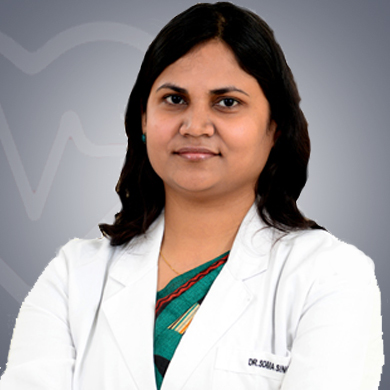
Infertility Specialist
BLK-Max Super Speciality Hospital , Delhi, India11 Years of experience
Speaks: English
Dr. Soma Singh is an IVF specialist and gynecologist and obstetrician in the Delhi NCR region. She has extensive hands-on experience in treating various gynecological disorders. She has more than 15 years of clinical experience. She is currently providing her services at BL Kapoor Super Specialty Hospital, New Delhi as a Consultant, IVF and Reproductive Medicine. She has also been associated with Bourn Hall IVF Clinic, Delhi as Consultant, IVF, and Infertility. She also worked at the Institute of reproductive medicine and Hindu Rao Hospital. Dr. Soma completed her MBBS University of Calicut Kerala in the year 2003. Later, in the year 2008, she completed MS in Gynecology/Obstetrics from Sarojini Naidu Medical College, Agra. She passed DNB in Obstetrics & Gynecology conducted by DNB board, Delhi in the year 2010.
Dr. Soma Singh is experienced in managing the infertility issues in both male and female. She is an expert in handling various complex cases related to infertility and manages the condition efficiently through reproductive medicine. Her area of service includes Pre and Post Delivery Care, Female Sexual Problems, Intra-Uterine Insemination (IUI) Treatment, Donor Insemination Surrogacy, Hormone Replacement Therapy (HRT), Bartholin's Cyst Treatment, Endometriosis Treatment, Uterine Prolapse Surgery, Intrauterine Device (IUD) Placement, Ovarian Cyst Removal, Microsurgical Epididymal Sperm Aspiration (MESA), Endometrial or uterine Biopsy, TESA or testicular sperm aspiration, Intracytoplasmic Sperm Injection (ICSI), In Vitro Fertilization (IVF), Percutaneous Epididymal Sperm Aspiration (PESA), PCOS Polycystic ovary syndrome treatment, Menopause treatment, Frozen Embryo Transfer, and Hysterectomy. Dr. Soma is a member of various organizations such as the Federation of Gynecologists of India, Indian Fertility Society, Association of Gynecologists and Obstetricians of Delhi, and Indian Society for Assisted Reproduction (ISAR).
The conditions that gynecologist Soma Singh treats are listed below:
Ovarian cysts, pelvic pain, endometriosis, and uterine fibroids are common gynecological conditions. Treatment of ovarian cyst depends on the age, type, size of the cyst, and symptoms. The doctor might suggest medication or surgery. Treatment of endometriosis includes hormonal contraceptives, patches, birth control pills, and vaginal rings. Uterine fibroids are treated through uterine artery embolization in which small particles are inserted into the arteries in the uterus.
You must see a gynecologist if you have any of the below-listed symptoms:
Recognizing symptoms as early as possible and consulting a gynecologist quickly often increase the chances of an effective treatment. The symptoms listed above suggest different gynecological conditions. Many of the conditions are successfully treated. If your symptoms indicate a serious health concern, consult a gynecologist who will design and treatment plan that is best for you.
The gynecologist works for 40-50 hours every week. They work five days a week and also attend emergency calls. The gynecologist sees approximately 20-25 patients in a day.
Dr Soma Singh performs a number of popular procedures listed below:
The gynecologist performs a wide range of procedures. the doctor evaluates the overall condition of the patient before performing any procedure. The specialist has reported a high success rate in performing various procedures with high precision and accuracy. The doctor also holds a rich experience in handling complex cases with ease. The specialist is proficient in using the latest techniques to perform the procedures and ensures that the patient recovers quickly. The doctor has deep subject knowledge and graduated from a reputed college.

Share Your Experience about Dr. Soma Singh

A gynecologist is a doctor who specializes in women's reproductive organs. Gynecologists are actively involved in overseeing women's health and healthcare. While a general physician might be able to treat minor women's health issues, the opinions of gynecologists are necessary when it is related to certain aspects of women's health. A gynecologist also monitors some medical conditions that her general practitioner takes care of. They also diagnose problems that women might be having with the reproductive organs, like polycystic ovarian syndrome and cervical cancer. They also check vaginal infections or urinary tract infections in women. Gynecologists even perform minor surgeries.
The tests required before and during the consultation by a gynecologist are listed below:
A woman should never ignore any of the above-listed symptoms as these can grow worse with time and may become difficult to treat if delayed. So, always consult your doctor and let them know all your symptoms related to the reproductive system. They may suggest a few diagnostic tests so that the condition can be diagnosed. Post diagnosis the gynecologist determines the treatment plan that is best for you.
You need to visit a gynecologist for your annual screening. You must see the doctor also if you experience symptoms like vaginal pain, abnormal bleeding in the uterus, and vulvar and pelvic pain. Some other symptoms that warrant a visit to a gynecologist are listed below:
Menstrual problems are very common among women. In case your menstrual cycle appears different than normal, see your gynecologist. It could be caused by stress or hormonal imbalances, but it can be a sign of ovarian issues or uterine anomalies. Ignoring menstrual problems can lead to reproductive problems.